Kauai, one of the USA’s inhabited Hawaiian Islands in the North Pacific, supports several populations of Laysan Albatrosses Phoebastria immutabilis. Although small, these populations are considered significant because their height puts them above predicted sea-level rises which are thought will seriously impact the much larger Laysan Albatrosses populations on the low-lying North Western Hawaiian islands. The Kauai albatrosses differ in their levels of protection and management, so are here treated as four separate populations.
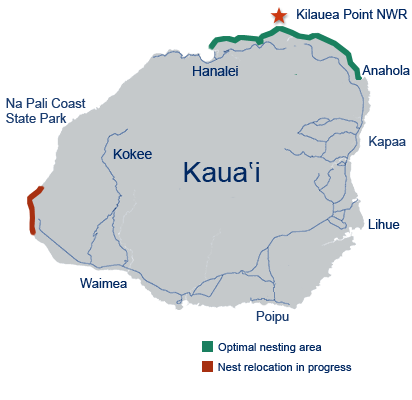
The North-east Kauai and Princeville populations are marked in green
Around 130 pairs breed within the Kilauea Point National Wildlife Refuge, although they are not readily visible to the public. Secure breeding opportunity within this refuge has recently been expanded by the building of a predator-proof fence.
Farther west on the island approximately 40 pairs breed within the community of Princeville where they are studied and protected by concerned inhabitants (click here)
Over 80 pairs attempt to breed annually on the south-west shore of Kauai within the US Navy’s Pacific Missile Range Facility Barking Sands (click here). Because these birds are a collision hazard to aircraft their eggs are removed each year; some of which have been given to foster parents elsewhere on the island as a conservation measure (click here).
In addition to these three separate populations, Laysan Albatrosses breed on private lands along the north-east coast of Kauai, in a 16-km stretch from Princeville to Anahola, east of Kilauea Point.
Four well-fenced spots occur in this coastal region where the birds are well protected but in unfenced sections breeding Laysans are at risk to domestic dogs Canis familiaris that are allowed to roam loose, with 25 adult birds known to have been killed by dogs in the 2012/13 breeding season. Hawaiian Department of Land and Natural Resources staff then went door-to-door in the neighbourhood and the killings stopped. Live traps have been used on unfenced properties to catch the most problematic dogs. Feral cats Felis catus are also deemed to be a problem and control activities take place by volunteers of the Kaua‘i Albatross Network.

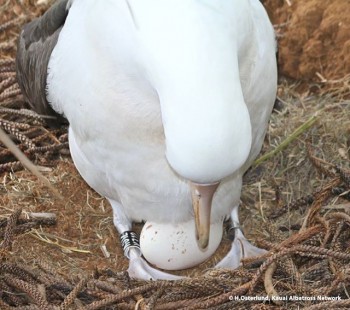
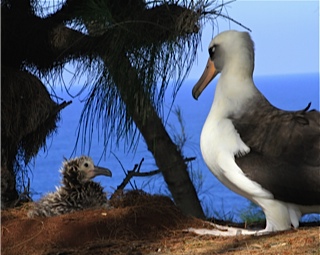
Laysan Albatrosses of the north-east shore of Kauai
The combined total of the Princeville to Anahola private properties saw 59 chicks fledge from 87 eggs laid (of which 68 hatched) in the 2013/2014 breeding season. Some 10-25% of the breeding birds are female-female pairs which lay double clutches (click here), giving opportunities for cross-fostering with eggs from Barking Sands, as has happened recently in the privately-owned Na Aina Kai Botanical Gardens. Non-breeding birds caught and banded at Barking Sands have also been released in the botanical gardens for some years, some of which have commenced to breed. In the past translocated birds were released within the Kilauea Point National Wildlife Refuge but this apparently no longer occurs.
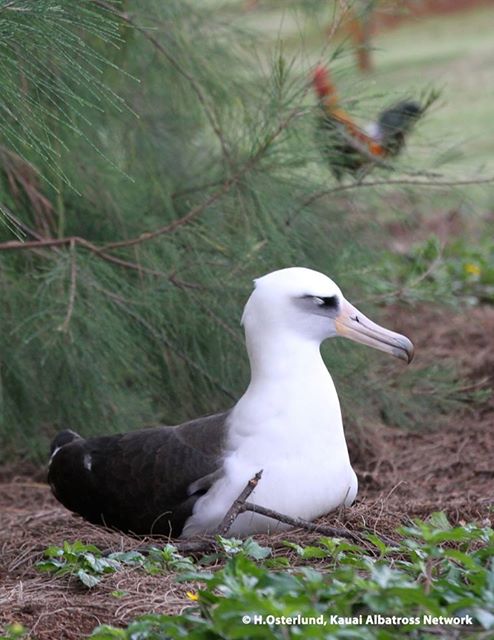
An incubating Laysan Albatross
A live-streaming remote camera operated by the Cornell Laboratory of Ornithology set up on a secure property in north-east Kauai went live on 27 January this year. Over the next five months until the chick (named "Kaloakulua", which refers to a phase of the moon when it hatched) successfully fledged in late June the “TrossCam” received nearly two million hits from 195 countries, with regular write-ups being posted. One notable event was when a stray dog showed up a few metres from the chick, fortunately without harming it (click here). The dog was later live-trapped and adopted.
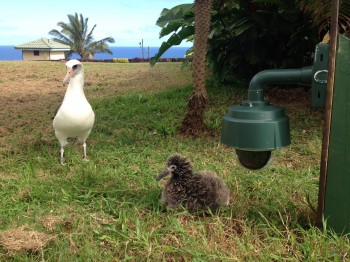
The albatross camera along with the chick it watched
All photographs by Hob Osterlund
It is intended to use the camera at a nearby nest site in the 2014/15 season now that egg-laying has commenced.
Global Positioning System (GPS) tags were placed on 12 adult birds in the Na Aina Kai Botanical Gardens this year as part of a collaborative study of the at-sea movements of several Hawaiian seabird species by Pacific Rim Conservation, Oikonos Ecosystem Knowledge and the U.S. Geological Survey’s Western Ecological Research Center (WERC-USGS). The birds have been tracked at sea for up to 79 days (click here). In addition, Kaloakulua received an archival geolocator tag before fledging in the hope it could be recovered for downloading when it returns to land after its first few years at sea as a juvenile.
With thanks to Lindsay Young, ACAP North Pacific News Correspondent, for information.
Selected Literature:
Arata, J.A., Sievert, P.R. & Naughton, M.B. 2009. Status Assessment of Laysan and Black-footed Albatrosses, North Pacific Ocean, 1923-2000. U.S. Geological Survey Scientific Investigations Report 2009-5131. Reston: U.S. Geological Survey.
Duffy, D.C. 2010. Changing seabird management in Hawai'i: from exploitation through management to restoration. Waterbirds 33: 193-207.
Naughton, M.B., Romano, M.D. & Zimmerman, T.S. 2007. A Conservation Action Plan for Black-footed Albatross (Phoebastria nigripes) and Laysan Albatross (P. immutabilis). Version 1.0.
Pyle, R.L. & Pyle, P. 2009. The Birds of the Hawaiian Islands: Occurrence, History, Distribution, and Status. Honolulu: B.P. Bishop Museum, Honolulu.
Vanderwerf, E.A. 2012. Albatrosses. In: Hawaiian Bird Conservation Action Plan. Honolulu: Pacific Rim Conservation. 11 pp.
Waid, R. 2005. The Majestic Albatross. Images of Kauai's Beloved Seabirds. Honolulu: Mutual Publishing. 51 pp.
Young, L.C. & VanderWerf, E.A. 2014. Adaptive value of same-sex pairing in Laysan albatross. Proceedings of the Royal Society Biological Sciences doi: 10.1098/rspb.2013.2473.
Young, L.C., Vanderwerf, E.A., Granholm, C., Osterlund, H., Steutermann, K. & Savre, T. 2014. Breeding performance of Laysan Albatrosses Phoebastria immutabilis in a foster parent program. Marine Ornithology 42: 99-103.
John Cooper, ACAP Information Officer & Hob Osterlund, Kauai Albatross Network, 14 December 2014

 English
English  Français
Français  Español
Español